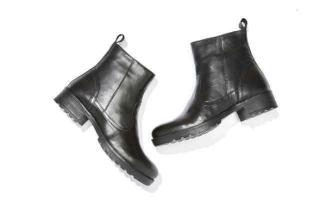
Are Men’s and Women’s Shoe Sizes the Same?
4 April 2025
Are Men's and Women's Shoe Size the Same?
Ever found yourself looking in the wrong section of a shoe shop, only to notice a pair you quite like the look of? Maybe the question crossed your mind about whether, as a woman, men’s shoes would fit you (or vice versa) - a size 8 is a size 8 after all… Right?
In this blog, we’ll answer this question in detail, along with a deep dive into the key differences between women’s and men’s shoe sizes, how to convert between them, and much more. By the end, you’ll know how to find a comfortable, stylish fit that’s exactly how you like it!
Here’s what we’ll cover:
- The difference between men's and women's shoe sizes.
- How to convert between men’s and women’s shoe sizes.
- How shoes should fit and how to find your perfect size.


What's the Difference Between Men's and Women's Shoe Sizes?
While shoe size numbers may look the same on men’s and women’s shoes, there are important structural and dimensional differences between the two that go beyond size labels. The differences come from shoe lasts, width variations, and other technical aspects of shoemaking.
But first, let's look at the main areas of difference:
- Length: Women’s shoes are typically about one full UK size smaller than men’s shoes of the same numerical size. For example, a UK women’s size 7 is roughly equivalent in length to a UK men’s size 6.
- Width: Women’s shoes are often slightly narrower, especially at the heel and forefoot. Men’s shoes are generally wider and built to accommodate broader feet.
- Shape and fit: The shape of the shoe last (the mould around which a shoe is built) also varies. Men’s shoe lasts tend to be wider and more angular, whereas women’s lasts are narrower at the heel and forefoot for a snugger fit.
This means that even if a man and a woman wear the same “size” on paper, the shoes will likely feel quite different in terms of fit and comfort.
It also means a man could wear a woman’s shoes or vice versa, if the size is converted correctly and the shape suits the foot. They’d just need to be mindful of the width and construction differences and be open to trying a half-size up or down to get the best fit.
A Quick Look at Lasts
The differences outlined above derive from shoe lasts, which are the 3D forms used to shape shoes, as well as width variations and overall foot proportions.
Historically, men's and women's lasts evolved separately as shoemakers crafted footwear based on broad assumptions about anatomical differences. Men's lasts were built with more room through the instep and forefoot to accommodate a wide foot, while women's were shaped with narrower heels and more defined arches.
These conventions became standardised over time, especially as mass manufacturing took hold. Modern footwear design still builds on these principles, although many unisex or fashion-forward styles are now developed using more neutral lasts for broader appeal.


How to Convert Between Men's and Women's Shoe Sizes
Knowing that there are differences in the sizing systems and their historical origins is great, but most people are interested in how to convert between the two. So, whether you’ve found the perfect style in the opposite department or you're helping someone shop for shoes, here’s a basic example for converting UK shoe sizes:

In general, if you're a woman purchasing men's shoes in UK, EU, or US sizes, it's recommended to go down 1 to 1.5 sizes. Women's size charts can be helpful for accurate conversions.
Always remember to check each brand’s size guide, as some styles may run small or large, and materials like leather can influence how the shoe feels once worn. We also advise measuring your feet width at the end of the day when they’re at their largest, as this will provide a more accurate fit. And if one of your feet is bigger than the other, measure the larger foot!
Keep in mind that size conversions aren't an exact science! Trying the shoes on is always the best option. It's also important to know your correct shoe size and understand how they should fit for your comfort.
What About Unisex Sizing?
Unisex shoes are typically sized using men's scales by default. If you're buying unisex styles and usually wear women’s sizes, you’ll generally need to size down by one full UK size. For example, if you usually wear a women’s UK 6, go for a UK 5 in unisex.
As unisex shoes tend to use a more neutral last, they may feel roomier than standard women’s fits but narrower than men's. If possible, always try on a pair or refer to brand-specific guidance.
How Should Shoes Fit & Finding Your Perfect Size
Getting the right size isn’t just about the number—it’s about how the shoe fits your foot. A proper fit ensures all-day comfort and helps prevent rubbing, blisters, or strain.
Here’s what to look for:
- Toe room: You should have about a thumb’s width of space between your longest toe and the front of the shoe.
- Secure heel: Your heel should feel supported but not squeezed. If it slips, the shoe may be too large.
- Width and support: The shoe should feel snug (not tight) across the widest part of your foot. If the sides feel constricted, consider a wider fit or a different style.
- Try with socks: Always try shoes on with the type of socks or tights you plan to wear with them day to day, as this will give you a representative fit.
Explore Our Collection and Get Help in-Store!
So, are men’s and women’s shoe sizes the same? Not quite. But once you understand the differences in size, width, and shape, converting between them becomes simple. Understanding how shoes are designed for different feet is also a great first step to finding your perfect pair.
Now that you know your size and fit, why not explore our latest collection and find your perfect pair? Our new-in women’s collection features the latest styles, each crafted with quality, comfort, and fit in mind.


